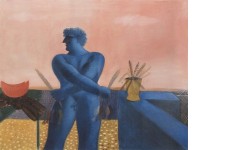Σχέδιο 196Ελαιογραφία 350Μικτή Τεχνική 111Υδατογραφία 14Ακρυλικά 275Collage 2Gouache 35Χαρακτική 9Τέμπερα 9Γλυπτική 3Νωπογραφία 3Παστέλ 10Λαδοπαστέλ 2Αυγοτέμπερα 1Λαδοτέμπερα 3
Ειδικές Πληροφορίες για τον Καλλιτέχνη
TITΛΟΣ ΕΡΓΟΥΔΟΞΑΣΜΕΝΟΣ ΑΝΤΡΑΣ ΣΤΗΝ ΠΑΡΑΛΙΑ
ΔΙΑΣΤΑΣΕΙΣ ΕΡΓΟΥΎψος : 200
Πλάτος : 251
ΥΛΙΚΟ ΚΑΤΑΣΚΕΥΗΣΕλαιογραφία (Λάδι σε καμβά)
ΥΠΟΓΡΑΦΗ ΚΑΛΛΙΤΕΧΝΗΠάνω Αριστερά
ΧΡΟΝΟΛΟΓΗΣΗ01-01-1982
ΕΛΕΓΧΟΣ ΓΝΗΣΙΟΤΗΤΑΣΔεν έχει ελεγχθεί

Footnotes
Painted in 1982.
Literature:
A. Fassianos, Adam Publications, Athens 1990, p. 60 (illustrated).
The low courtyard wall
gives us a sense of identity
A. Fassianos
Grand yet surprisingly down to earth, monumental but gem-like, universal yet quintessentially Greek, this enchanting and beautiful painting captures the eternity of the moment - a key feature of Fassianos art,1 confirming the painters international reputation as a modern master.
Full of life and virile strength, like his famous ancestor, the Minoan fisherman from the island of Thera who carries two similar bundles of fresh fish, Fassianos youth worships the sun and celebrates the sea. Embraced by the miracle of the Greek summer light and suffused in the luminous atmosphere of the Aegean, he demonstrates the artists spontaneous delight in fluid and graceful natural forms, the sensuality he distils from simple, everyday pleasures, his power to seize the day through timeless forms. Having just emerged from the water with the dampness of the sea still visible on his body, the artists young hero looks as immobile and eternal as a Naxian kouros or a frozen image of an old and recurrent dream.
Jean-Marie Drot, former director of the French Academy in Rome, notes that for Fassianos, the artists ultimate goal is to transform the most elemental aspects of everyday life, the most familiar figures into divinities, retracing, in reverse, the ancient tradition that allowed the great Olympian gods to assume the guise of mortals and mingle with them, talk to them and even seduce them without scaring them.2 We are the same with the ancients says the artist because we bathe in the same waters, we see the same hills, the same light that has always been there. This is Greekness.3
According to Koichi Tanikawa, one of Japans foremost artists, Fassianos appeal lies in the fact that his work makes one imagine a life with warm, southern sunshine, a carefree, leisurely pleasure, and the bliss of being satisfied with oneself. And these are the effects also found in Picasso at Antibes, Bonnard at Le Cannet, and Dufy in Nice.4 In the same vein, art critic H. Kambouridis notes: What makes Fassianos work so fascinating is that he confronts us with a childs innocence and frankness, despite his well-informed background and experience. His creativity, innocence and childhood joy with which he made his first toys or sketches on the sand or a piece of paper, have remained intact. From this reservoir he draws energy and remains ever charming to our eye and soul.5
Just as the fish carried by his glorified man of the beach cannot live except in water, Fassianos cannot live without painting whatever he feels about life, whatever touches him: a simple scarf left on a table, a slice of watermelon, a vase with some humble straws, a low courtyard wall that gives us a sense of identity.6
1. M. Faucher, as quoted in Fassianos, Adam publ., Athens 1989, p. 13.
2. J.M. Drot, as quoted in Alecos Fassianos, Athlos, Mythos, Eros [in Greek], Kastaniotis publ., Athens 2004, p. 82.
3. as quoted in B. Kalamaras, Bicycling Forever [in Greek], Eleftherotypia daily, 21.04.2004.
4. K. Tanikawa, A Grecian Smile in Fassianos Drawings, Adam publ., Athens 1994, p. 24.
5. H. Kambouridis, preface in the Fassianos exhibition catalogue [in Greek], Larissa Contemporary Art Centre, Larissa 1997, p. 7.
6. A. Fassianos, The Low Wall, in Today, and Tomorrow and Yesterday [in Greek], Kastaniotis publ., 1990, p. 86.